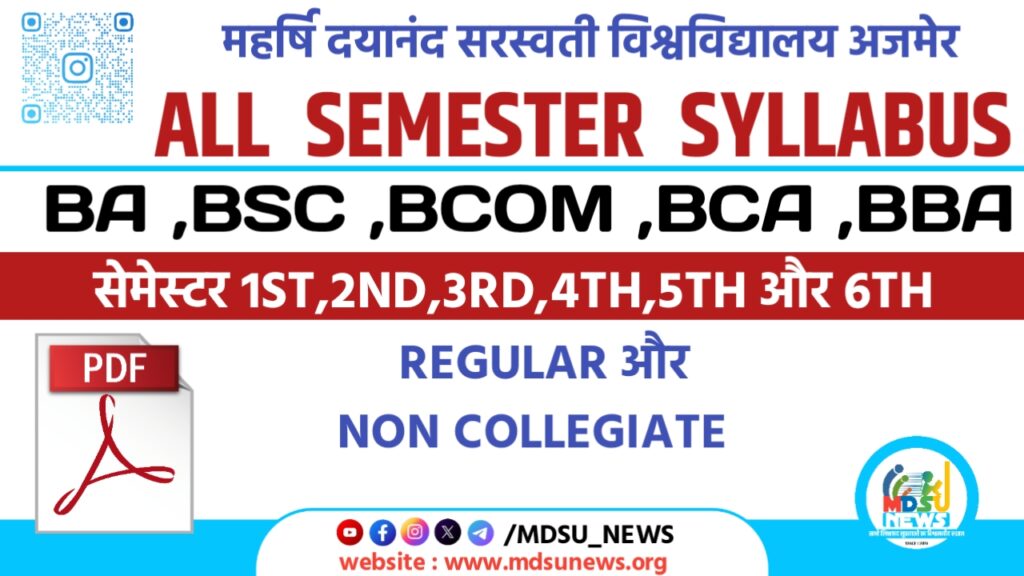B.A. (Part-I) (Semester-I)
Economics Examination, 2023 (Held in 2024)
Discipline Specific Core Course (DSCC)
Micro Economics
Duration of Examination: 3 Hours
परीक्षा की अवधि: 3 घण्टा
Max. Marks: 70 पूर्णांक: 70
Instructions to the Candidates:
परीक्षार्थी के लिए निर्देश:-
Note :- The question paper is divided into 02 Parts : Part- A & Part B.
Part- A
Part-A Will consist of 10 compulsory questions. There will be at least three questions from each unit and the word limit of each answer will be approximately 50 words. Each question will carry 02 marks. (Marks-10×2=20)
Part-B
Part-B Will consist of 10 questions. At least three quests from each unit will be asked and the student will have to answer 05 questions, selecting At least one questions from each unit and the word limit of each answer will be up to 400 words. Each question will carries 10 Marks. (Marks-5×10=50)
नोट:- प्रश्न पत्र दो भागों में होगा। भाग-अ और भाग-ब
भाग-अ
भाग-अ में 10 अनिवार्य प्रश्न होंगे। प्रत्येक इकाई से कम से कम तीन होंगे और प्रत्येक प्रश्न का उत्तर 50 शब्दों तक सीमित होगा। प्रत्येक प्रश्न
दो अंक का होगा।
भाग-ब
भाग-ब में 10 प्रश्न होंगे। प्रत्येक इकाई में से कम से कम तीन प्रश्न निर्धारित किए जाएं और छात्र को प्रत्येक इकाई से कम से कम एक प्रश्न का चयन करते हुए पाँच प्रश्नों का उत्तर देना होगा। प्रत्येक प्रश्न का उत्तर 400 शब्दों तक सीमित होगा। प्रत्येक प्रश्न 10 अंक का होगा। (5×10 = 50 अंक)
Part भाग-अ
Unit-1/ इकाई-I
(1) If the price of a commodity rises by 10% and is quantity demanded falls from 80 units to 60 units, calculate coefficient of price elasticity of demand.
यदि किसी वस्तु की कीमत में 10% वृद्धि के परिणामस्वरूप इस वस्तु की माँग 80 इकाई से घट कर 60 इकाई रह जाती है, वस्तु की माँग की कीमत लोच के गुणक की गणना कीजिए।
(2) Discuss briefly the central problem of “How to Produce”.
कैसे उत्पादन किया जाए” की केन्द्रीय समस्या को संक्षेप में समझाइए ।
(3) Distinguish between ‘Change in Demand’ and ‘Change in Quantity Demanded’.
‘मांग में परिवर्तन तथा ‘मांग मात्रा में परिवर्तन में अंतर स्पष्ट कीजिए।
(4) Discuss concept of marginal Rate of substitution.
प्रतिस्थापन की सीमान्त दर की अवधारणा को समझाइए।
Unit-II / इकाई-II
(5) State any two reasons for the operation of diminishing returns to a factor.
साधन के धममान प्रतिफल के लागू होने के किन्हीं दो कारणों को बताइए।
(6) “Under all market conditions, average revenue and Marginal Revenue are equal to each other”. Do you agree with the given statement? Give valid reason for your answer.
“सभी बाजार परिस्थितियों में, औसत आगम तथां सीमांत आगम बराबर होते है।’ क्या आप इस कथन से सहमत है? अपने उत्तर के लिए मान्य कारण दीजिए।
(7) State with reason the behaviour of average fixed cost as output is increased
जैसे-जैसे उत्पादन में वृद्धि होती है औसत स्थिर लागत का व्यवहार क्या रहता है? कारण बताइए।
Unit-III/ इकाई-III
(8) State the pareto criterion of social welfare
सामाजिक कल्याण के परेटो मानदण्ड को बताइए।
(9) “Profit is a reward for uncertainty bearing”. Elaborate the given statement.
‘लाभ अनिश्चितता वहन करने का पुरस्कार है।” दिए गए कथन की व्याख्या कीजिए।
(10) Distinguish between differential rent and scarcity rent.
भेदात्मक लगान तथा दुर्लभता लगान में अन्तर स्पष्ट कीजिए।
Part-B / भाग-ब
Unit-I / इकाई-1
(11) Explain the principle of Equi- marginal utility. According to this principle how does a consumer maximise his satisfaction.
सम-सीमान्त उपयोगिता ध्यान नियम को समझाइए। इस नियम के अनुसार एक उपभोक्ता अपनी संतुष्टि को अधिकतम किस प्रकार करेगा।
(12) Explain the main properties of indifference curves.
तटस्थता वक्रो की मुख्य विशेषताओं की व्याख्या कीजिए।
(13) Explain the following (Any two): (i) Substitution Effect (ii) Price Mechanism (iii) Giffen Goods.
निम्नलिखित को समझाइए:- (कोई दो) (अ) प्रतिस्थापन प्रभाव (ब) कीमत सयंन्त्र (स) गिफिन वस्तुएँ
Unit / इकाई -II
(14) Explain the conditions of price and output determination of a firm under perfect competition
पूर्ण प्रतियोगिता की स्थिति में एक फर्म द्वारा कीमत तथा उत्पादन निर्धारण की दशाओं को समझाइए ।
(15) Explain the following (Any two): (1) Least Cost Combination (ii) Inter relationship of short run cost curves (iii) characteristics of oligopoly market.
निम्नलिखित को समझाइए (कोई दो) :- (क) न्यूनतम लागत संयोग (ख) अल्पकालीन लागत वक्रो के अर्न्तसम्बन्ध (ग) अल्पाधिकार बाजार की विशेषताएँ।
(16) Discuss the behaviour of Total Product, Marginal Product and Average Product with the help of schedule and diagram as more and more units of only one input are employed while keeping other inputs as constant.
जब केवल एक आगत की इकाइयों की मात्रा बढ़ाई जाती है और अन्य आगतों को स्थिर रखा जाता है तो कुल उत्पाद सीमान्त उत्पाद तथा औसत उत्पाद के व्यवहार की सारणी तथा रेखाचित्र की सहायता से व्याख्या कीजिए।
(17) What are the conditions of price discrimination? Discuss the price and output determination under dis- criminating monopoly.
मूल्य विभेद की शर्तें क्या है? विभेदात्मक एकाधिकार में कीमत तथा उत्पादन निर्धारण की व्याख्या कीजिए।
Unit-III / इकाई – III
(18) Critically examine the liquidity preference theory of interest.
ब्याज के तरलता अधिमान सिद्धान्त की आलोचनात्मक व्याख्या कीजिए।
(19) Explain the following (Any two): (i) Modem Theory of Rent (ii) Modern Theory of wages (ii) Classical Welfare Economics.
निम्नलिखित को समझाइए (कोई दो):- (क) लगान का आधुनिक सिद्धान्त (ख) मजदूरी का आधुनिक सिद्धान्त (ग) प्रतिष्ठित कल्याणकारी अर्थशास्त्र
(20) Discuss the conditions of Pareto efficiency in production, consumption and exchange with the help of suitable diagrams.
उत्पादन, उपभोग तथा वितरण में परेटो कुशलता की शर्तों को उपयुक्त रेखाचित्रों की सहायता से समझाइए ।



